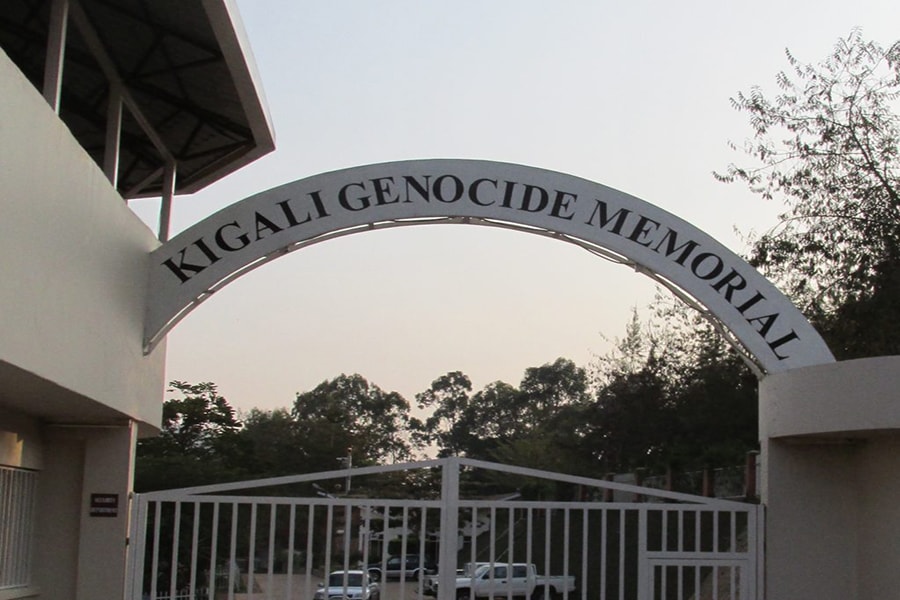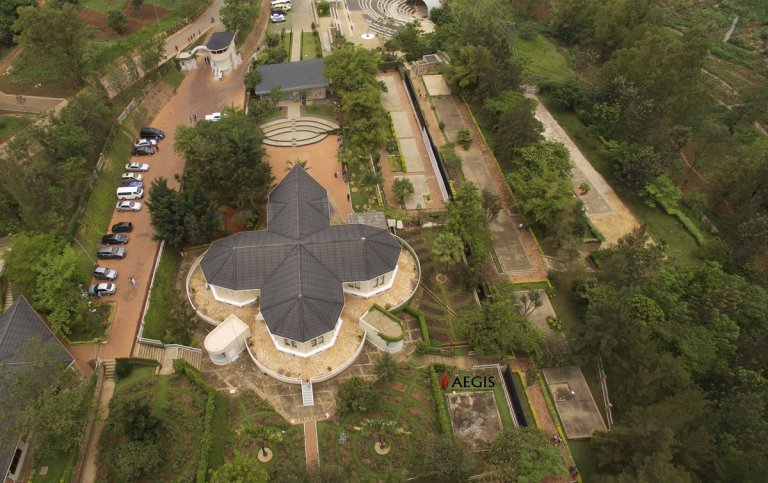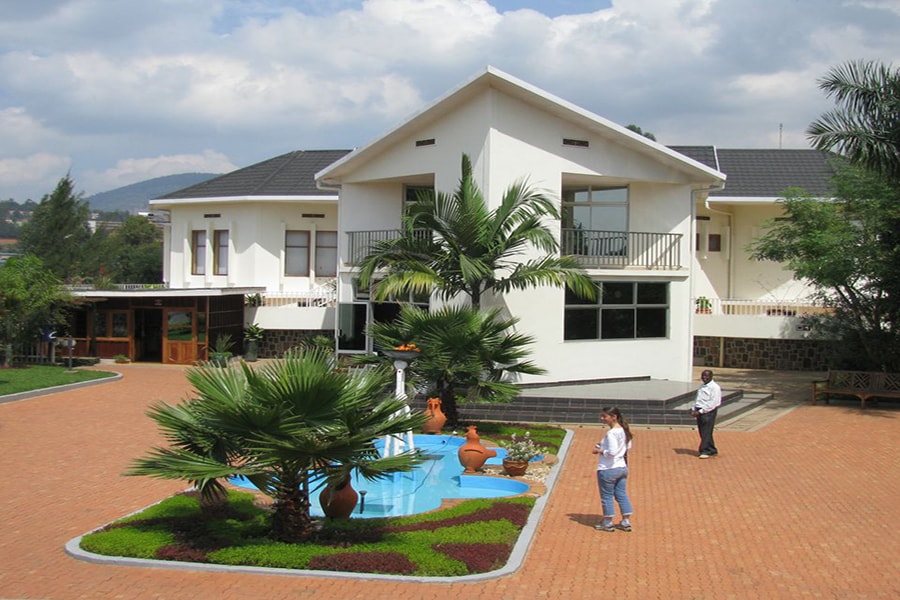Kigali Genocide Memorial: In Memory of the 250,000 Victims of the Rwandan Genocide
The Kigali Genocide Memorial stands as a somber reminder of the devastating events of the 1994 Rwandan Genocide. This site, located on Gisozi Hill in Kigali City, serves as the final resting place for an estimated 250,000 victims of a tragedy that claimed nearly a million lives in just 100 days. It is one of several genocide memorials across Rwanda dedicated to honoring the victims and ensuring the world remembers the consequences of hatred and division.
A Sacred Place of Remembrance

The Main Entrance of Kigali Genocide Memorial
Formally inaugurated on April 7, 2004, during the 10th anniversary of the genocide, the Kigali Genocide Memorial provides a space for survivors, families, and visitors to pay their respects. Managed by the Aegis Trust, a UK-based organization, in partnership with Rwanda’s National Commission for the Fight Against Genocide (CNLG), the memorial serves as a platform for education, remembrance, and healing. Aegis Trust also engages in policy-making, research, and advocacy to prevent future atrocities worldwide.
Architectural Design and Layout

An aerial View of Kigali Genocide Memorial Centre
The memorial’s architecture reflects the narrative of Rwanda’s history, structured around three key periods: before, during, and after the genocide. The site includes:
- Main Historic Exhibition: A detailed chronological display of Rwanda’s history, leading up to and including the genocide.
- Children’s Memorial Exhibition: A poignant tribute to the youngest victims, showcasing their photographs, personal stories, and artifacts.
- Comparative Genocide Exhibition: Known as “Wasted Lives,” this section highlights genocides in other parts of the world, drawing parallels to the events in Rwanda.
- Memorial Gardens: Covering four acres, these serene gardens include ten mass graves and provide a tranquil space for reflection. Each rose planted symbolizes a life lost but also represents hope for a brighter future.
- National Genocide Documentation Centre: A hub for education and research, promoting awareness and strategies to prevent future genocides.
Exploring the Memorial
Our History Room
The first exhibition room, titled “Our History,” introduces visitors to Rwanda’s rich cultural heritage before the genocide. Large photographs depict everyday life, from women breastfeeding their children to elders engaged in traditional games. The room also features an iconic image of King Yuhi V Musinga, symbolizing Rwanda’s pride and resilience. Alongside these visuals is an inscription: “This is about our past and our future, our nightmares and our dreams, our fear and our hope, which is why we begin where we end, with the country we love.”
Descent to Genocide
This section vividly illustrates the horrors of 1994. Dimly lit and somber, it displays graphic images of mass graves, bones, and the tools used in the killings. A striking photograph of Kigali’s St. Famille Church, where over 30,000 victims were burned alive, underscores the unimaginable cruelty. Accounts of complicity, including from religious leaders, provide a chilling reminder of how institutions failed to protect the vulnerable.
After the Genocide
The “After the Genocide” room highlights Rwanda’s journey towards reconciliation and recovery. Photographs of orphaned children and devastated families capture the lingering pain. In a circular hallway, artist Ardyn Halter’s stained-glass windows depict Rwanda’s rise from the ashes, with imagery of skulls giving way to symbols of unity and hope. This room emphasizes the resilience of survivors and the efforts to rebuild a nation.
Memorial Gardens
The gardens are designed to evoke peace and reflection. Cascading water features and roses symbolize life and renewal. Visitors are encouraged to sit and meditate, finding solace in the greenery that signifies Rwanda’s resurgence. The gardens’ tranquility contrasts starkly with the horrors commemorated within the memorial’s walls, offering a message of hope.
Educational and Global Significance
The Kigali Genocide Memorial goes beyond commemoration. Its Documentation Centre engages youths and scholars in discussions on genocide prevention and reconciliation. It compares Rwanda’s experiences with other genocides in Germany, Cambodia, Bosnia, and Japan, fostering global awareness about the dangers of prejudice and division.
Key Facts and Insights
- Number of Memorial Sites in Rwanda: Over 250 registered genocide memorials exist across the country.
- The Wall of Names: An ongoing project at the memorial aims to document the names of all victims. Many remain unidentified, highlighting the magnitude of the tragedy.
- Derogatory Terms Used: During the genocide, Tutsis were dehumanized with terms like “cockroaches” and “Tall Trees.”
- Ending the Genocide: The Rwandan Patriotic Front (RPF), led by Paul Kagame, ended the genocide in July 1994.
A Warning for Future Generations

The Main Building of the Genocide Memorial
The Kigali Genocide Memorial is more than a burial site; it is a testament to humanity’s capacity for both destruction and recovery. The management emphasizes that the memorial is for everyone, stating, “These are everyone’s places as much as Rwanda’s. They should remain as a warning for future generations about the consequences of hatred and division.”
Visiting the Kigali Genocide Memorial is an emotional journey that underscores the fragility of peace and the importance of unity. It serves as a reminder to the global community of the need to confront hatred and work together to build a more compassionate world.
Other Genocide Memorial Centres in Rwanda
Rwanda is home to numerous genocide memorial centers, each bearing witness to the tragic events of the 1994 Genocide against the Tutsi. These centers honor the victims and serve as a somber reminder of the importance of preventing future atrocities. Apart from the Kigali Genocide Memorial which remains the most comprehensive memorial, hosting detailed exhibits on the genocide and Rwanda’s journey of recovery, below is an overview of major genocide memorial centers in Rwanda:
Bisesero Genocide Memorial Centre
The Bisesero Genocide Memorial, located in the Karongi District, is a significant site that commemorates the resilience and suffering of the Tutsi population during the genocide. Known as the “Hill of Resistance,” Bisesero was where thousands of Tutsi took refuge and tried to defend themselves against the Interahamwe militia and government forces. Despite their courageous efforts, an estimated 50,000 people were killed in Bisesero. The memorial consists of nine small buildings symbolizing the nine communities that existed in the area before the genocide. Visitors can view the remains of the victims, which are preserved as a stark reminder of the brutality of the genocide. The site also highlights the delayed intervention by the international community, which contributed to the massive loss of life in the region.
Murambi Genocide Memorial Centre
Situated in Nyamagabe District, the Murambi Genocide Memorial stands on the grounds of an unfinished technical school where approximately 50,000 Tutsi sought refuge, falsely assured of protection. Instead, they were betrayed and massacred in April 1994. The site is one of the most haunting genocide memorials, as it preserves the bodies of victims in their original state using lime treatment. Visitors can see rows of rooms with remains laid out, providing a chilling yet powerful visual representation of the atrocity. The memorial also features mass graves and displays personal belongings of the victims, including clothing and household items, as a testament to their humanity. Murambi serves as a place for reflection on the consequences of hate and the importance of unity.
Ntarama Genocide Memorial Centre
Located in the Bugesera District, Ntarama was originally a Catholic church that became a site of massacre during the genocide. Over 5,000 Tutsi who sought refuge there were brutally killed. The church has been preserved as a memorial, and inside, visitors can see remnants of the victims’ lives, including clothing, personal items, and even the blood-stained walls of the church. One of the most disturbing features of this site is the display of skulls and bones of the victims, offering a grim reminder of the scale of the violence. The site also includes a room where children were targeted, with inscriptions detailing the horrific methods used by the killers. Ntarama Genocide Memorial Centre is a symbol of how places of sanctuary became sites of unimaginable horror.
Nyamata Genocide Memorial Centre
Also located in Bugesera District, Nyamata Genocide Memorial is housed in another former Catholic church where over 10,000 people were massacred. The church remains a solemn site, with clothing, rosaries, and personal belongings of the victims displayed on the church benches and floor. The site also contains mass graves where visitors can pay their respects. What sets Nyamata apart is the emphasis on telling the individual stories of the victims and survivors, making the tragedy deeply personal. The church structure itself bears evidence of the massacre, with bullet holes and bloodstains serving as reminders of the brutal attack. The site underscores the betrayal by some religious leaders and institutions during the genocide.
Nyarubuye Genocide Memorial Centre
The Nyarubuye Genocide Memorial, located in the Kirehe District, is another former church where thousands of Tutsi were massacred after being deceived into seeking refuge. The attackers used brutal methods, including grenades and machetes, to kill the victims. Today, the site preserves the remains of the victims and their belongings, including cooking utensils, clothes, and identity cards. The memorial also serves as a place for survivors to share their testimonies, fostering reconciliation and education. Nyarubuye highlights the cruelty of the genocide and the need for vigilance against hate and division.
Rebero Genocide Memorial Centre
The Rebero Genocide Memorial Centre, situated on Rebero Hill, honors the memory of politicians, public figures, and individuals who were targeted and killed for their opposition to the 1994 Rwandan Genocide. This site serves as a poignant reminder of the courage and sacrifices made by those who resisted the genocidal violence, standing as a symbol of resilience and defiance in the face of hatred and injustice. The memorial not only commemorates the victims but also educates future generations about the importance of resistance, justice, and peace.
Nyanza-Kicukiro Genocide Memorial
The Nyanza-Kicukiro Memorial stands as a poignant reminder of the horrors of the 1994 Rwandan Genocide, specifically commemorating the massacre of over 5,000 Tutsi individuals who sought refuge at the ETO Kicukiro technical school, located in the Kicukiro District of Kigali. This tragic event occurred during the most intense period of the genocide, highlighting the systemic failure of international peacekeeping efforts. The victims had been abandoned by the United Nations peacekeepers, whose mission, instead of protecting civilians, was largely limited to observing and maintaining a neutral stance. Despite being aware of the mass killings taking place across the country, the UN forces, under the leadership of Lieutenant-General Romeo Dallaire, were not authorized to intervene or prevent the violence. This site, therefore, represents not only the devastating loss of life but also a stark condemnation of the international community’s inaction during the genocide. The massacre unfolded as the Tutsi refugees were rounded up and slaughtered by the genocidal forces, despite their desperate hope for protection under the UN’s watch.
The memorial emphasizes the failure of the United Nations to take decisive action, drawing attention to the devastating consequences of their inaction. Through this remembrance, the memorial serves as a powerful symbol of both the individual tragedies of the victims and the collective lesson of the global community’s responsibility to prevent such atrocities from ever happening again. The Nyanza-Kicukiro Memorial not only honors those who lost their lives but also stands as a critical reminder of the need for international vigilance, intervention, and accountability in the face of ethnic and political violence.
Each of these memorials tells a part of the larger story of the 1994 Genocide against the Tutsi, reminding visitors of the need for remembrance, justice, and the collective responsibility to prevent future atrocities. These sites play an essential role in Rwanda’s healing process and efforts to educate future generations about the consequences of hate and division.
